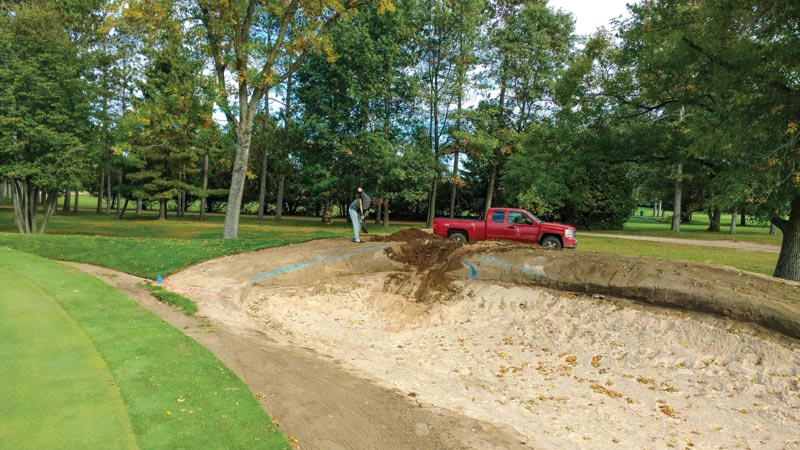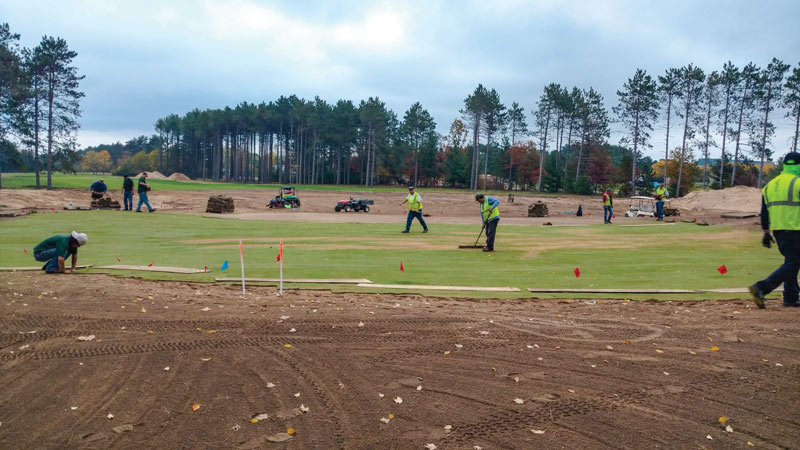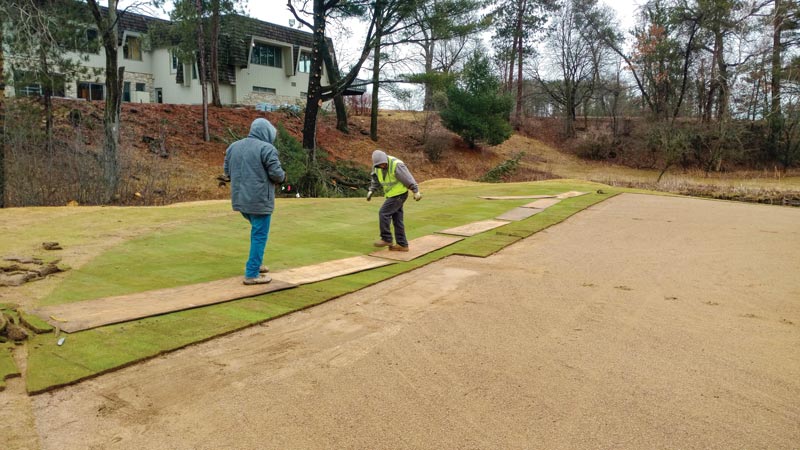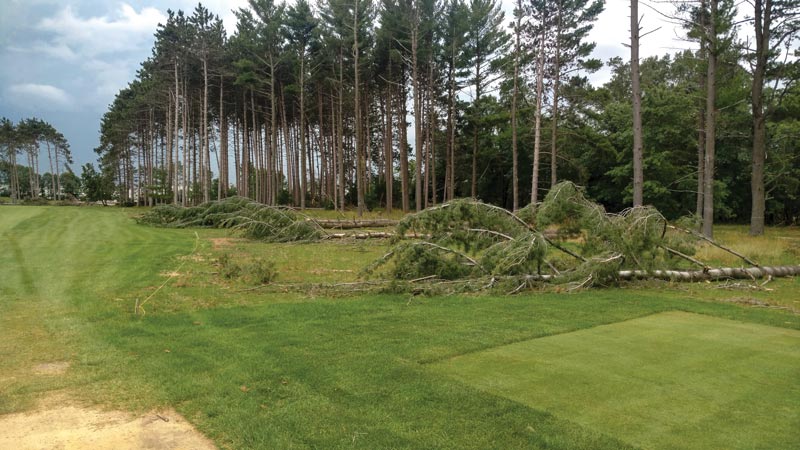
A $3 million renovation at Stevens Point (Wis.) Country Club was funded by money from a settlement with DuPont, maker of the herbicide Imprelis, which had wiped out about 2,500 trees on the course. Redesign work has opened the course up considerably. Photo by Andrew Krugler
Imprelis had the potential to be one of the worst things ever to happen to Stevens Point Country Club.
As it turns out, Imprelis — that ill-fated herbicide that indeed lived up to its hype for being a game changer, but for all the wrong reasons — ultimately proved to be quite beneficial for the central Wisconsin course.
“There are so many different ways it could have turned out,” says Craig Haltom, president of golf management for the Oliphant Companies and an 11-year GCSAA member. “For me, it was a lesson in, if you’re able to make a reinvestment in a golf facility, it can pay off. I’m not a person who would just advocate change for the sake of change. But if you’re able to make a reinvestment ... I’ve seen people respond to it.
“What I say all the time is, ‘We can’t be the people who move things sideways. We have to move things forward.’”
Things could have gone sideways for Stevens Point CC quite easily.
But that’s getting ahead of the story.
Trees, trees and more trees
Chartered in 1925, Stevens Point Country Club opened in 1927. Prolific architect Larry Packard came along in 1968, scrapped the original nine-hole layout and turned it into 18 holes. Its defining characteristic? Trees. Lots and lots of trees. According to the Stevens Point CC origin story, some of its early members planted mostly red and white pines — as many as 50,000, by one count.
“As much as any course I know,” Haltom says, “it was defined by rows and rows of red pines, basically two to three rows deep over the entire golf course.”
Four decades on from its redesign in ’68, Stevens Point languished. An unquestioned aesthetic beauty, it had a few routing issues. Its irrigation system needed work. Membership was declining.
“It looked like an older, run-down country club,” recalls Jimmy Cavezza, construction and grow-in superintendent at Stevens Point for the recent renovation, who currently is serving the same function at The Club at Lac La Belle in Oconomowoc, Wis. “It was in need of help.”
Haltom is a bit more diplomatic.
“I wouldn’t say the golf course was tired,” Haltom says. “But at least in my head, there was always this other vision sitting out there.”
From a superintendent’s standpoint, the old Stevens Point CC was a challenge.
“It had classic, tree-lined fairways — very tight, very claustrophobic,” says Matt Shafer, a 10-year GCSAA member who last month celebrated his one-year anniversary as superintendent at Stevens Point. “It was difficult to maintain maintenance-wise. There were so many trees. It had very high, classic-style bunkering. You just needed more people to maintain it.”
Stevens Point might have been due for a refresh, but, like many courses since the heady days of the late 1980s to early ’90s, it wasn’t exactly awash in money.
Then along came DuPont, which produced Imprelis, the herbicide that killed off a bunch of Stevens Point’s course — then helped breathe new life into it.
The Imprelis saga
Imprelis came on the national scene in 2010.
Registered by the EPA in October of that year, the selective herbicide (its active ingredient was aminocyclopyrachlor) was hailed as a game changer. It was odorless, said to have low toxicity to mammals and to work well to control weeds that other herbicides struggled to control, and, because of its low application requirements, was touted as environmentally friendly. DuPont billed Imprelis as “the most scientifically advanced turf herbicide in over 40 years,” and said it had proven safe in over 400 field trials. It was sold to landscapers, lawn care professionals and, yes, golf course superintendents.
One superintendent, in the pages of GCM, called it a “miracle product.”
Imprelis worked — quite well, actually. But then, trees started getting sick and dying. Norway spruce and white pine were particularly vulnerable, though there was evidence that non-coniferous trees such as maples, honey locusts, lilacs, sycamores and alders were also susceptible to damage from Imprelis. The Midwest was particularly hard hit.
After more than a little back and forth among users, DuPont and the EPA, a handful of lawsuits, and threats of more to come, DuPont voluntarily pulled Imprelis from the market in August 2011, just before the EPA issued a stop-sale order.
In some cases, users settled directly with DuPont, though eventually there was a class-action suit involving 15 states. DuPont established a payout based on tree size: $30 for a 1-foot tree, and up to $19,000 for a tree 96 to 100 feet.
Filed claims numbered close to 40,000. DuPont said it expected to pay out nearly $2 billion.
Imprelis settlement: Stevens Point’s slice of the pie
Remember all of those trees planted by Stevens Point CC’s early members? By the time Imprelis came through, Cavezza estimates they towered 80 to 100 feet. The club lost an estimated 2,500 trees to the damage.
The settlement figure from DuPont to Stevens Point hasn’t been made public, but it was substantial, with two commas in it. Haltom speculates it was among the largest awarded to a golf course.
At that point, Stevens Point — which by then was being managed by Oliphant Companies — had a decision to make.
“There were still lots of trees out there, but all the members saw the trees decline,” Haltom says. “But nobody knew how far it would go. Is every tree going to die? They ended up with a substantial settlement and allowed the funds to address what the golf course was to become. They had good accountants at the club, who realized there were tax incentives to spending that money to restore the golf course and do improvements. They’d take a tax hit if they took the funds and put them in a rainy-day fund. How much do you reinvest, and what could you put away?”



Scenes from the Stevens Point Country Club renovation. The private golf course was open, at least partially, throughout the work, which included the addition of new bunkers, a few completely new holes, a new irrigation system and improved routing. Photos by Jimmy Cavezza
Haltom and staff pitched a substantial renovation, with Haltom handling the design work for the renovation. After a series of town hall meetings, the membership was sold.
“We suggested from the beginning that the golf course could come out of it much improved,” Haltom says, “and that we could do it within a manageable budget. We were literally trying to make the best out of what at the time was a devastating situation. And that’s a credit to the membership. They could have said, ‘Let’s replant. Yes, it’s going to take a generation.’ I’m glad that’s not the direction it went, but it could have gone that way.
“A lot of comments I got from the beginning were, ‘Are we now going to have a links course?’ They thought it would have just no trees — essentially a wasteland. When you’re trying to present changes to a golf course, people have to be extremely trusting of your vision. A tiny percentage wanted to see us replant all the trees. Once people decided they could trust the vision, people got behind it and were very supportive of it.”
A renovated Stevens Point: ‘It still has plenty of trees’
Work began in the winter of 2015-16. The first task was to clear the damaged and dying trees. Through connections he had made previously when working on nearby Sand Valley Golf Resort, Haltom called in the big guns.
“We brought in some giant equipment to do the type of clearing you do in a clear-cut situation, versus trying to peck away at it,” Haltom says.
Renovation work began in August 2016. Parts of the course remained open during construction; the smallest was a six-hole loop.
Haltom’s design embraced the natural sand lying underfoot.
“It still has plenty of trees,” he says. “If you went out today, you could still say it’s defined by trees. But what I proposed was, rather than replanting acres and acres of red pines, was to open up the natural sandy area and make that the central feature of what the course was going to be. I proposed a design that said, ‘Let’s make this about the cool, natural sandy areas.’ And we ended up with a golf course that, I think, is a lot of fun to play and looks great and wasn’t dependent on a tree-planting strategy.”
The redesign opened up the course and added new tees — five sets in all — and bunkers and a few hundred yards in length, as well as new runoff areas and green surrounds. New greens were constructed, and routing issues resolved. Underneath it all was a new, modern irrigation system. The project also featured a new pool and clubhouse.
All for about $3 million.
Construction roughly kept to an aggressive timeline, and regrassing began in the spring of 2017. That June, a massive storm — with straight-line winds of 60 to 70 mph — roared through the area.
“Everything was grassed. Everything was seeded,” Cavezza recalls. “We were just in the grow-in phase, trying to tread lightly. All of a sudden, we had another 1,000 trees down. It definitely felt like somebody punched us in the gut, for sure. It set us back, but we were able to get it cleaned up, and we were able to make a few improvements to make the place even better.”

In June 2017, construction was nearly complete and grow-in well underway at Stevens Point Country Club when a huge storm tumbled another 1,000 or so trees, setting back the renovation. Designer Craig Haltom considers last season the first full season the refreshed course had come into its own. Photo by Jimmy Cavezza
Response to the new course was positive. Reviews have been glowing, and membership is up dramatically.
Haltom considers last season the first for the new Stevens Point CC.
“I’d say last year was the first full season of presenting this thing as a finished product,” he says. “Our fescues were growing. And it’s just going to get better and better as it goes. That’s how it is for all golf courses. I was fortunate to spend a lot of time with Bill Coore building Sand Valley, and I remember him saying it takes about 10 years for these things to really turn into something. There’s just no way around it. That’s the truth.
“This whole project is a credit to the membership. This couldn’t have happened without them. I waved my arms and put some pretty pictures up, and they said, ‘Let’s try it.’ We could have continued on with what we had, but a lot of things lined up. It all came together, even with bumps in the road, and I would say what we ended up with is a much better golf course.”
Andrew Hartsock is GCM’s managing editor.